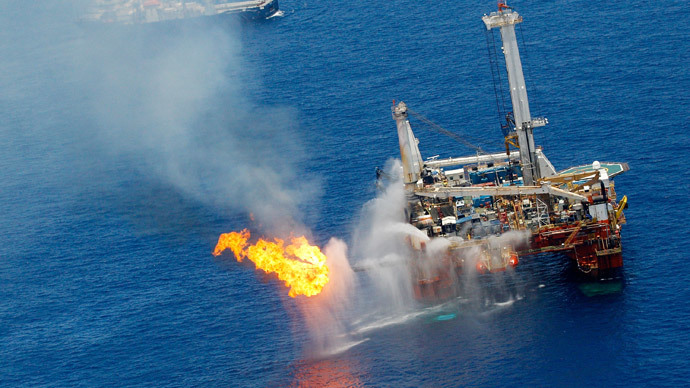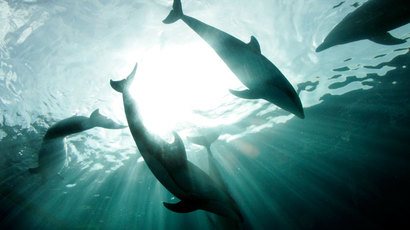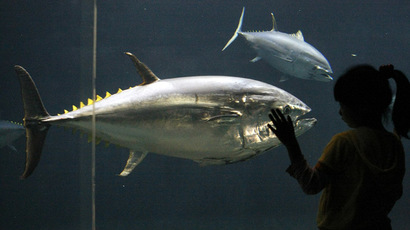BP oil spill left Rhode Island-sized oily ring on seafloor

The 2010 BP oil spill that resulted in 172 million gallons of oil in the Gulf of Mexico has, four years later, left an oily “bathtub ring” about the size of Rhode Island on the sea floor surrounding the site of the Macondo well, according to new research.
About 10 million gallons of oil has collected on the sea floor near the former site of the Deepwater Horizon rig and BP-operated Macondo well, where the oil spewed from April 20 to July 15 in 2010, according to a study by David Valentine, a University of California Santa Barbara geochemist, and co-author Christopher Reddy, a marine chemist at Woods Hole Oceanographic Institute.
The study, published Monday in ‘Proceedings of the National Academy of Sciences,’ found that the oil spill has left several splotches in the Macondo well area, some with more oil residue than the 1,200-square-mile “bathtub ring.”
Valentine said though there are no chemical signature tests given the oil has since degraded, the source of the oil is obvious.
"There's this sort of ring where you see around the Macondo well where the concentrations are elevated," Valentine said, according to AP.
He added that oil levels found inside the ring were as much as 10,000 times higher than outside the ring. A chemical ingredient of oil was found on the sea floor, from two-thirds of a mile to a mile below the water’s surface.
BP questioned the study’s findings, especially since the oil can no longer be tested given its degraded state.

In an email to AP, spokesman Jason Ryan said, "the authors failed to identify the source of the oil, leading them to grossly overstate the amount of residual Macondo oil on the sea floor and the geographic area in which it is found."
Though such chemical analysis is impossible at this point, study authors Valentine and Reddy said other evidence point to the Deepwater Horizon disaster: the depth of the oil, the area it encompasses, and the distance from the Macondo well.
The study was praised by marine scientists Ed Overton, of Louisiana State University, and Ian MacDonald, of Florida State University, neither of whom were involved in its conclusions, according to AP.
Though the spill is more than four years old, scientists are still measuring - and debating - the total ecologicalimpact of the BP spill. For now, Reddy said they believed their findings validated earlier research that found deep water coral was coated with oil and damaged from the spill.
The Deepwater Horizon explosion killed 11 people and polluted Gulf waters that wash onto the shores of five US states as oil gushed from the drilling rig for nearly three months before the flow was brought to a halt.
In all, prosecutors said over 4 million barrels of oil spilled into the Gulf, making it the largest accident of its kind in petroleum industry history. Around 16,000 miles of coastline were affected and, according to the National Park Service, over 8,000 animals died as a result.

In early September, a federal judge ruled that BP had acted with gross negligence before the spill, indicating that the corporation may have to pay billions of dollars in fines.
US District Court Judge Carl Barbier also wrote in his ruling that two other oil companies — Transocean and Halliburton — acted negligent as well, but failed to find them as responsible as BP with regards to the spill. Transocean owned the Deepwater Horizon rig, but drilling rights were leased to BP; Halliburton was in charge of the “cementing” process on the doomed drilling site.
The three companies, Barbier wrote, are "each liable under general maritime law for the blowout, explosion and oil spill," but the bulk of the blame — specifically 67 percent — will rest on BP. According to Bloomberg News, BP may next face fines as high as $18 billion — the maximum penalty under the Clean Water Act — and has already put aside $3.5 billion to cover those costs.
Despite the ruling, energy companies can count on political allies in states like Louisiana to defend their interests. For instance, in June, Louisiana Gov. Bobby Jindal signed into law legislation that rescued dozens of oil and gas companies from a lawsuit over long-term damage done to the state’s wetlands.
Experts said the law may very well thwart future claims against energy companies, including those against BP.
In a letter urging Jindal to veto the legislation, Louisiana Attorney General Buddy Caldwell wrote that the bill included “very broad and all-encompassing language” and “may have other potential serious unintended consequences."
“No one can currently quantify or identify all of the causes of action which will be swept away if this bill becomes law,” the letter warned
“In the coming years perhaps the proponents of the bill can tailor legislation more narrowly drawn which does not portend such a broad and vague attack on the abilities of the State, and most importantly, local governmental entities to protect their citizens.”














